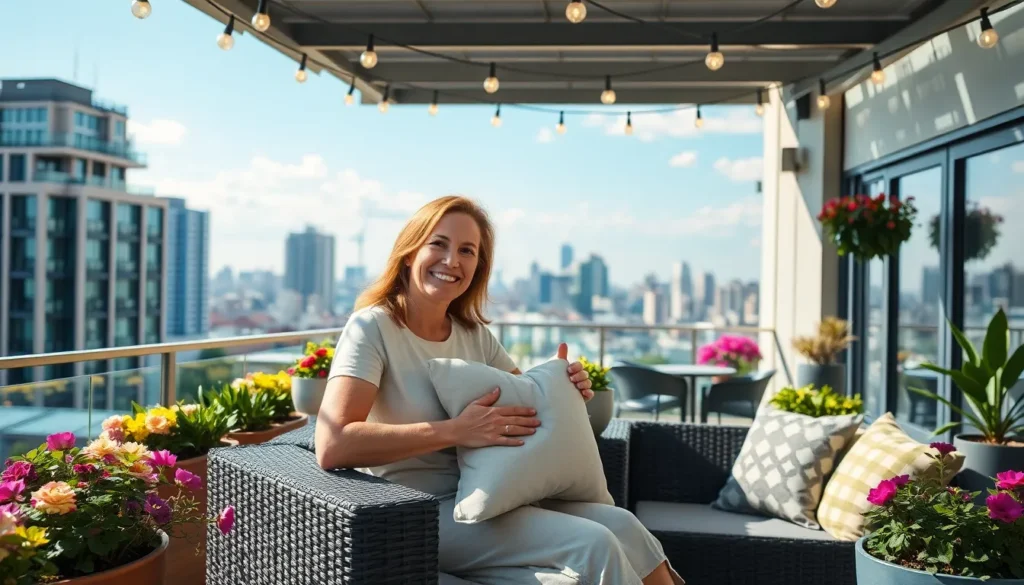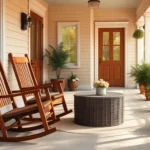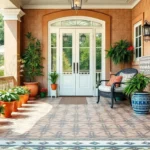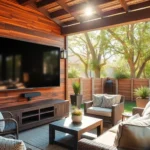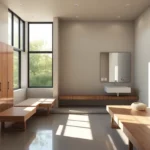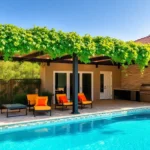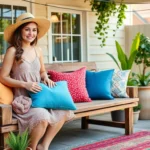We’ve all dreamed of transforming that empty rooftop space into our own urban oasis. Whether you’re working with a sprawling penthouse terrace or a cozy apartment rooftop, outdoor rooftop patios offer unlimited potential for creating stunning entertaining spaces that maximize your home’s square footage.
The beauty of rooftop design lies in its unique challenges and opportunities. We’re dealing with exposed elements, incredible views, and the chance to create something truly spectacular above the city streets. From weather-resistant furniture selections to strategic wind barriers, every design choice matters when you’re building up instead of out.
Our carefully curated rooftop patio ideas will help you navigate everything from budget-friendly DIY projects to luxury installations. We’ll explore creative answers for privacy, lighting, plant selections, and furniture arrangements that’ll transform your rooftop into the ultimate outdoor retreat. Let’s jump into the inspiring possibilities waiting above your head.
Create a Stunning Rooftop Garden Paradise
Transform your barren rooftop space into a lush green sanctuary that thrives even though urban challenges. We’ll guide you through essential gardening strategies that maximize beauty while withstanding harsh rooftop conditions.
Choose Weather-Resistant Plants
Selecting hardy varieties ensures your rooftop garden flourishes year-round even though intense sun, strong winds, and temperature fluctuations. We recommend drought-tolerant options like lavender, rosemary, and ornamental grasses that require minimal water while delivering maximum visual impact. Succulent varieties including sedum, echeveria, and jade plants create stunning displays while surviving extreme weather conditions.
Native species adapt naturally to your local climate and require less maintenance than exotic alternatives. Consider regional favorites like purple coneflowers, black-eyed Susans, and native grasses that attract beneficial insects while reducing water needs. These plants establish strong root systems that anchor better during windstorms.
Evergreen shrubs provide year-round structure and privacy screening for your rooftop paradise. Boxwood, juniper, and dwarf pine varieties maintain their appearance through all seasons while creating natural windbreaks for more delicate plants.
Install Raised Planter Boxes
Building elevated planters protects plant roots from temperature extremes while improving drainage on flat rooftop surfaces. We suggest using cedar or composite materials that resist weathering and provide excellent insulation for root systems. Standard heights between 18-24 inches offer optimal growing depth for most vegetables and flowering plants.
Strategic placement maximizes both functionality and visual appeal across your rooftop garden space. Position larger planters along perimeter walls to create privacy screens while placing smaller boxes in clusters for ever-changing visual groupings. This arrangement allows easy access for maintenance while creating distinct garden zones.
Drainage systems prevent water accumulation that damages both plants and rooftop structures. Install drainage holes every 6-8 inches along planter bottoms and add gravel layers beneath soil for improved water flow. Consider self-watering systems for planters in areas with limited water access.
Add Vertical Garden Walls
Living walls maximize growing space on compact rooftops while creating stunning focal points that transform blank surfaces. We recommend modular systems with built-in irrigation that support climbing plants like ivy, clematis, and flowering vines. These installations require minimal floor space while delivering maximum green coverage.
Trellis structures support climbing vegetables and flowers while adding architectural interest to your rooftop garden. Install sturdy metal or wooden frameworks that withstand wind loads while providing adequate support for mature plants. Popular climbing options include tomatoes, beans, and morning glories that create natural privacy screens.
Pocket planters offer flexible vertical growing answers for herbs and small flowering plants in limited spaces. Mount these systems on walls or railings to create herb gardens within arm’s reach of outdoor cooking areas. Choose varieties like basil, mint, and thyme that thrive in shallow growing conditions while providing fresh ingredients for rooftop entertaining.
Design a Cozy Outdoor Living Room
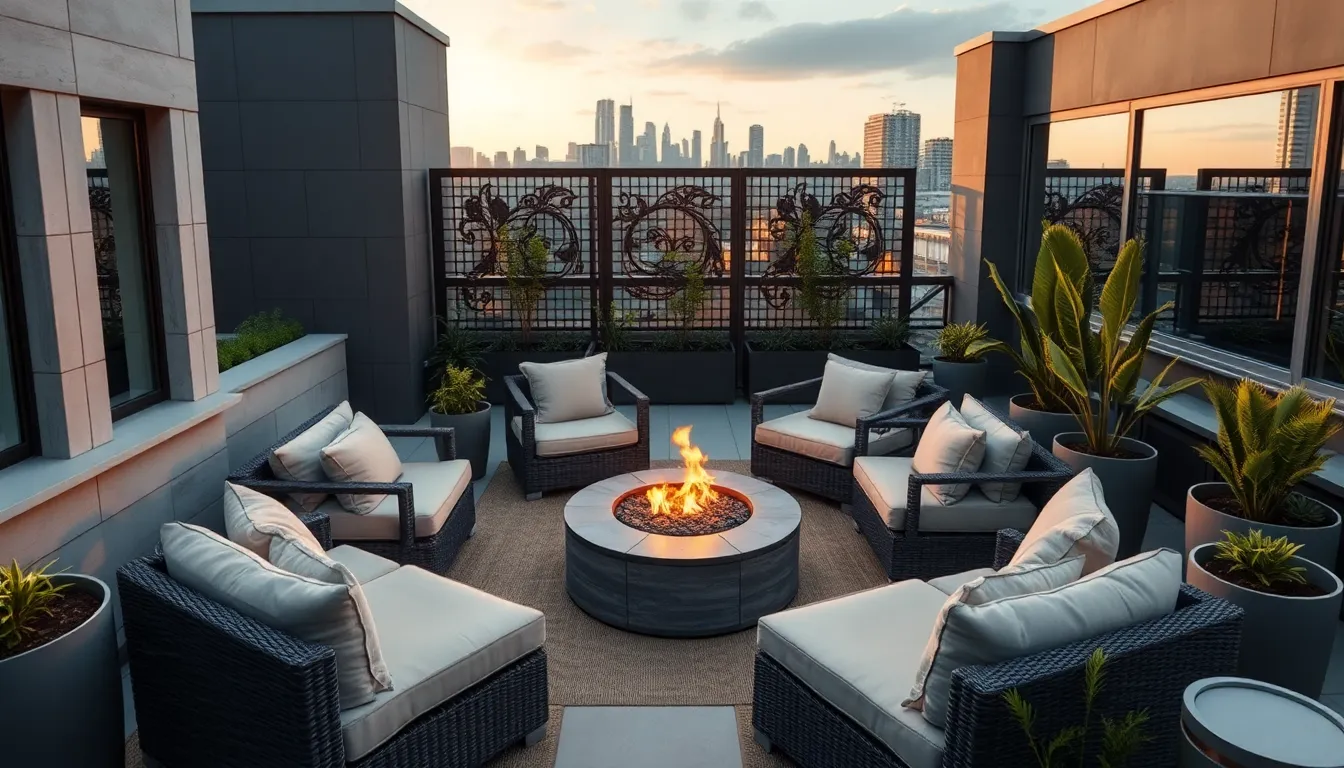
Transforming your rooftop patio into a comfortable outdoor living space requires thoughtful furniture selection and strategic design elements. We’ll focus on creating an inviting environment that rivals any indoor living room while withstanding outdoor conditions.
Select Durable Outdoor Furniture
Material choices make all the difference when furnishing your rooftop patio. Treated wood, aluminum, and synthetic wicker offer superior weather resistance against sun, wind, and rain exposure. We recommend investing in pieces that combine style with longevity rather than settling for furniture that’ll deteriorate quickly.
Modular furniture systems provide the flexibility your rooftop space demands. These versatile pieces allow you to reconfigure seating arrangements for different occasions, from intimate gatherings to larger entertainment events. Multi-functional furniture like storage ottomans or convertible tables maximize your limited rooftop square footage.
Practical considerations should guide your furniture selection process. Look for pieces with quick-drying cushions, rust-resistant hardware, and UV-protective finishes. Lightweight options make rearranging easier while stackable chairs offer convenient storage during harsh weather.
Create Intimate Seating Areas
Conversation clusters work better than linear seating arrangements for fostering connection. Arrange chairs, loveseats, or benches in circular or L-shaped configurations around central focal points like fire pits or coffee tables. This setup encourages natural interaction while making your rooftop feel more intimate.
Natural partitions help define separate zones within your larger rooftop space. Tall planters, outdoor curtains, or decorative screens create cozy nooks without blocking airflow or views. We suggest using these elements to establish distinct areas for dining, lounging, and entertaining.
Scale matters when designing intimate seating arrangements. Smaller furniture groupings feel more welcoming than oversized pieces that dominate the space. Consider creating multiple seating areas rather than one large arrangement to accommodate different group sizes and activities.
Add Weather-Resistant Cushions and Textiles
Solution-dyed acrylic fabrics resist fading, mold, and moisture better than traditional materials. These high-performance textiles maintain their color and texture even though constant exposure to UV rays and precipitation. We recommend choosing cushions and pillows made from these durable synthetic materials for long-lasting comfort.
Maintenance simplicity should influence your textile choices. Polyester fabrics offer easy cleaning and quick drying capabilities, making them practical for rooftop environments. Look for removable, machine-washable covers that simplify regular upkeep and seasonal deep cleaning.
Color coordination enhances your rooftop’s visual appeal while reflecting your personal style. Choose patterns and hues that complement your furniture and architectural elements without overwhelming the space. Neutral tones with accent colors create sophisticated looks that photograph well and remain timeless.
Outdoor rugs anchor seating areas while adding warmth and texture to hard rooftop surfaces. Weather-resistant materials like polypropylene or recycled plastic provide durability without sacrificing style. These rugs help define spaces and reduce wind noise while being easy to clean and store.
Install Shade Solutions for Comfort
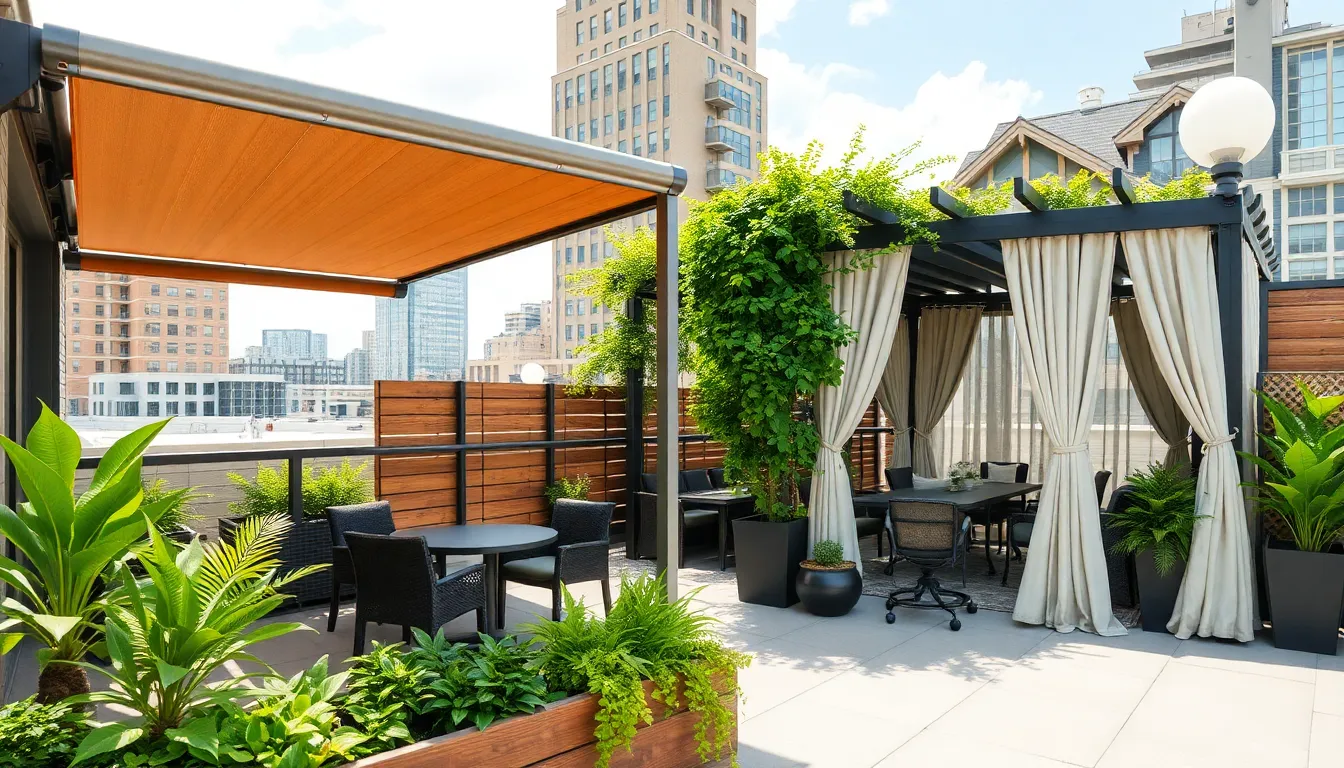
Rooftop patios need proper shade answers to remain comfortable throughout the day. Strategic shade installations transform harsh sun exposure into pleasant outdoor experiences.
Set Up Retractable Awnings
Retractable awnings offer the perfect balance of flexibility and protection for rooftop spaces. These versatile systems allow you to extend shade when needed or retract completely to enjoy full sunlight. Chicago rooftop designs frequently incorporate awnings to complement outdoor kitchen layouts, ensuring year-round comfort and usability.
Installation of retractable awnings works especially well for dining and lounging areas where weather conditions change throughout the day. Modern awning systems come with motorized controls for easy operation and can withstand rooftop wind conditions. Weather sensors automatically retract the awning during strong winds, protecting your investment.
Use Pergolas and Gazebos
Pergolas create structured shade while adding architectural interest to rooftop patios. Aluminum pergolas painted black effectively filter sunlight and support additional features like ceiling fans or outdoor curtains. These structures can accommodate climbing plants for natural shade coverage or fabric canopies for immediate protection.
Gazebos provide fully covered options that make rooftop spaces usable even during less favorable weather conditions. Customizable pergola designs allow you to add curtains for privacy or install outdoor fans for enhanced ventilation. Both options create defined outdoor rooms that feel intimate and protected.
Create Privacy Screens
Privacy screens are essential for urban rooftop settings where neighboring buildings create visibility concerns. Strategic placement of screens using materials like wood, metal, or outdoor curtains attached to pergolas creates customizable enclosure levels. Dense bamboo or tall grasses in planter boxes serve as natural privacy barriers while adding greenery to the space.
Curtain tracks on pergolas offer adjustable privacy answers that you can modify based on your needs. Combining natural elements with manufactured screens creates layered privacy that feels organic rather than restrictive. These installations work particularly well when positioned to block sightlines while preserving desirable views.
Incorporate Ambient Lighting Features

Transforming your rooftop patio into an enchanting evening retreat requires strategic ambient lighting that creates warmth and atmosphere. We’ll explore three essential lighting answers that combine functionality with visual appeal to make your outdoor space welcoming day and night.
String Edison Bulb Lights
String Edison bulb lights deliver that perfect vintage charm we’re looking for in rooftop design. The soft, warm glow from these oversized bulbs creates an intimate atmosphere that encourages relaxation and conversation among guests.
We recommend stringing these lights across pergolas, along railings, or overhead between anchor points to highlight exact seating zones. Edison bulbs work particularly well when arranged in a grid pattern above dining areas or draped in gentle curves over lounge spaces. Their vintage aesthetic complements both modern and rustic rooftop designs while providing sufficient illumination for evening activities.
Position these lights at varying heights to create visual depth and avoid harsh shadows. We suggest using dimmable options to adjust brightness levels throughout the evening as natural light fades.
Install Solar-Powered Fixtures
Solar-powered fixtures offer an eco-friendly lighting solution that eliminates wiring complications and reduces electricity costs. These sustainable options charge automatically during daylight hours and illuminate your rooftop space without requiring electrical connections.
We find solar lanterns especially effective when clustered along pathways or positioned at different heights to create ambient layers. Solar stake lights work well for defining garden borders or highlighting planters, while larger solar fixtures can serve as statement pieces in central gathering areas.
Modern solar technology provides reliable performance with LED bulbs that maintain consistent brightness for 8-10 hours after a full day’s charge. We recommend choosing fixtures with weather-resistant construction and backup battery systems for cloudy days.
Add Fire Bowls and Lanterns
Fire bowls serve as stunning centerpieces that combine warmth with flickering ambient light. These features naturally draw people together and extend the usable hours of your rooftop patio during cooler evenings.
We suggest positioning fire bowls in central locations where they can radiate heat to multiple seating areas without creating safety hazards. Modern propane models offer convenient operation with adjustable flame heights, while wood-burning options provide authentic crackling sounds and aromatic experiences.
Lanterns complement fire bowls by adding decorative layers of light throughout the space. We recommend mixing hanging lanterns suspended from pergola beams with tabletop versions placed on side tables and dining surfaces. Battery-operated LED lanterns provide consistent light without flame safety concerns, while traditional candle lanterns create romantic flickering effects for special occasions.
Combining these lighting elements with strategic placement creates multiple zones of illumination that transform your rooftop into a magical evening destination.
Build an Outdoor Kitchen and Dining Space
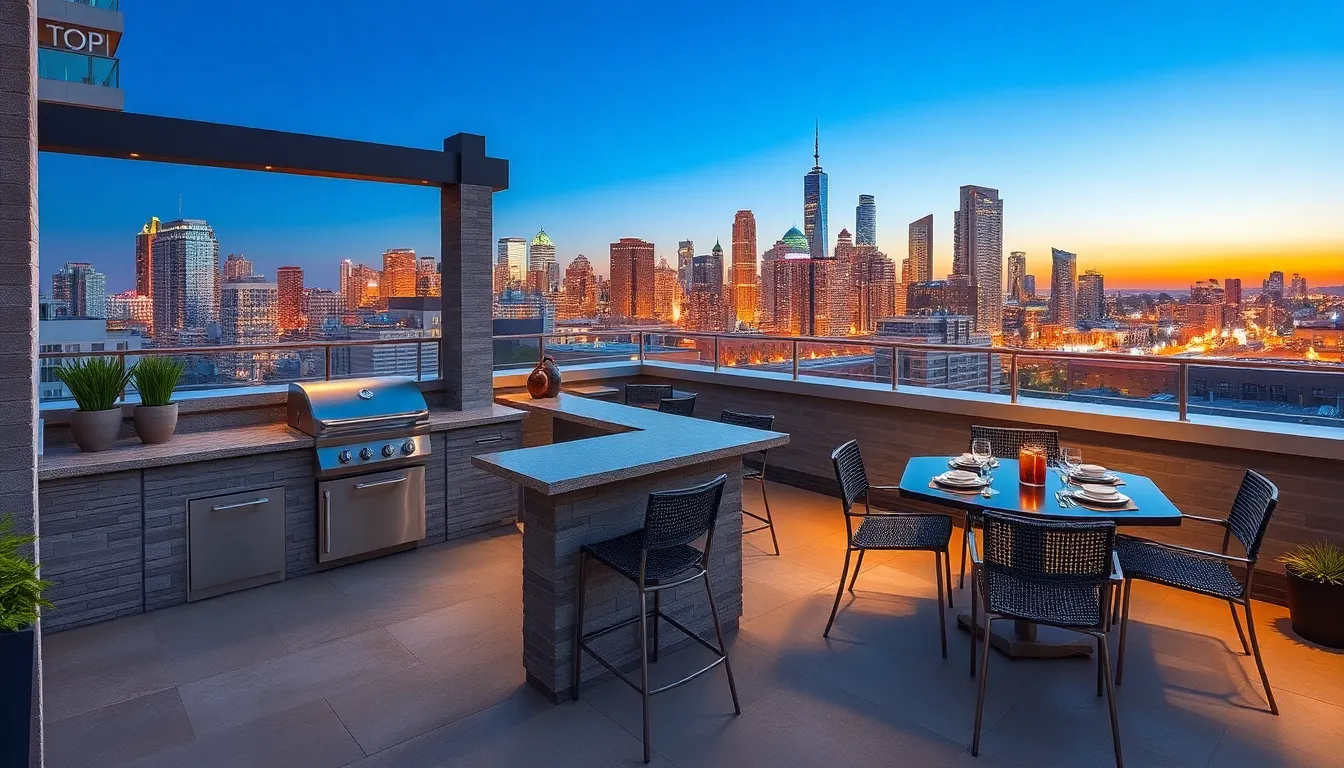
Creating an outdoor kitchen transforms your rooftop into a complete entertaining destination. Weather-resistant materials like stainless steel appliances and stone countertops withstand harsh urban elements while maintaining functionality and style.
Install a Built-In Grill Station
Building a grill station serves as the centerpiece of your rooftop kitchen design. Position the grill under a pergola or awning to provide essential shade protection and weather coverage during cooking sessions.
Adding proper ventilation helps manage smoke dispersal effectively in confined rooftop spaces. Surround your grill with countertops on both sides to create dedicated areas for food preparation and serving convenience.
Installing storage cabinets beneath the counter space keeps grilling tools and supplies organized. Consider incorporating a small refrigerator or wine cooler to complete your outdoor cooking setup.
Create a Bar and Counter Area
Incorporating bar height counters with comfortable stools creates a natural social hub for entertaining guests. This elevated area doubles as a serving station where visitors can gather while you prepare meals.
Using durable materials like concrete, stone, or treated wood ensures your bar surface withstands constant exposure to elements. These weather-resistant options maintain their appearance through multiple seasons of use.
Designing the counter with an overhang provides comfortable legroom for seated guests. Adding electrical outlets enables you to incorporate small appliances like blenders for outdoor cocktail preparation.
Add Outdoor Dining Furniture
Investing in weather-resistant dining furniture completes your rooftop kitchen and dining experience. Modular sectional seating offers flexibility for different group sizes and entertainment styles.
Arranging furniture to maximize city views while maintaining smooth traffic flow creates an optimal dining environment. Tables with integrated umbrella systems provide adjustable shade options during sunny afternoon meals.
Choosing lounge chairs with quick-dry cushions ensures comfort after unexpected weather changes. Position dining sets to create intimate conversation areas while keeping the space functional for larger gatherings.
Add Water Features for Tranquility
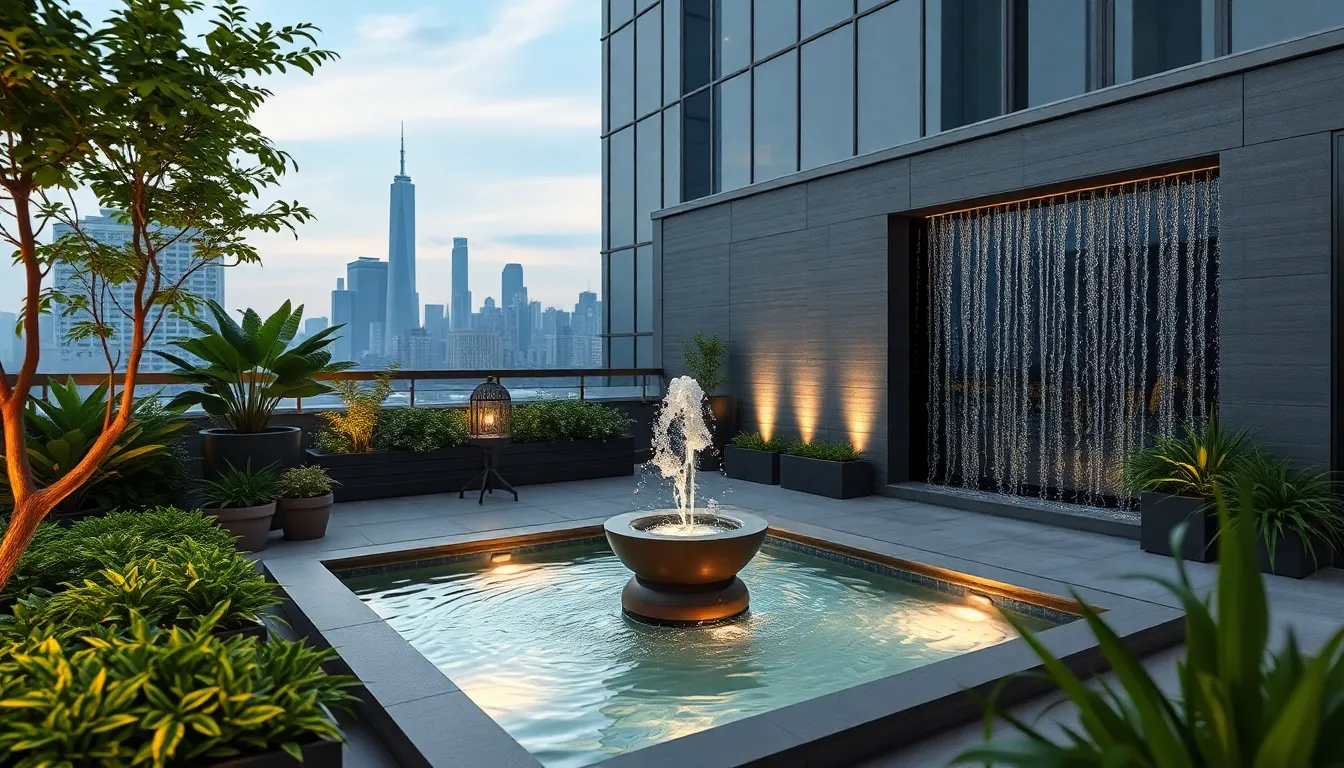
Water elements transform rooftop patios into serene urban retreats that provide both visual beauty and soothing ambient sounds. These features create a peaceful atmosphere that masks city noise while adding sophisticated elegance to our outdoor spaces.
Install Small Fountains
Small fountains work perfectly for rooftop patios because they use minimal water volume while delivering maximum impact. We can choose from freestanding models that serve as sculptural art pieces or integrate fountains directly into planter boxes for a seamless garden design. Modern minimalist fountains double as aesthetic focal points while generating gentle white noise that drowns out urban distractions.
Sculptural fountain designs enhance our rooftop’s visual appeal through clean lines and contemporary materials. These water features require less maintenance than larger installations and can operate on simple recirculating systems. We’ll find that fountain placement near seating areas maximizes the calming sound effects while creating intimate conversation zones.
Create Reflecting Pools
Reflecting pools add elegant sophistication to rooftop spaces by capturing sky reflections and surrounding architecture. We can design shallow pools with clean geometric lines that complement modern outdoor furniture and create stunning visual depth. These water features work especially well when positioned to reflect dramatic city skylines or cloud formations throughout the day.
Weight considerations make shallow reflecting pools ideal for rooftop installations compared to deeper water features. We can enhance these pools by incorporating surrounding seating areas or strategic greenery placement for added tranquility. LED underwater lighting transforms reflecting pools into magical evening focal points that extend our rooftop’s usability after dark.
Add Water Wall Elements
Water walls maximize tranquil ambiance while minimizing floor space requirements on compact rooftops. We can integrate these vertical features into privacy screens or create standalone installations that serve dual aesthetic and functional purposes. The gentle cascade of water provides consistent ambient sound while adding dramatic visual interest to plain walls or boundaries.
Privacy screen integration allows water walls to define separate rooftop zones while maintaining open sight lines. These installations often include LED backlighting that creates stunning nighttime effects and extends our outdoor entertainment hours. We can customize water wall materials from natural stone to modern metal panels that complement our existing rooftop design elements.
Design Multi-Level Entertaining Areas
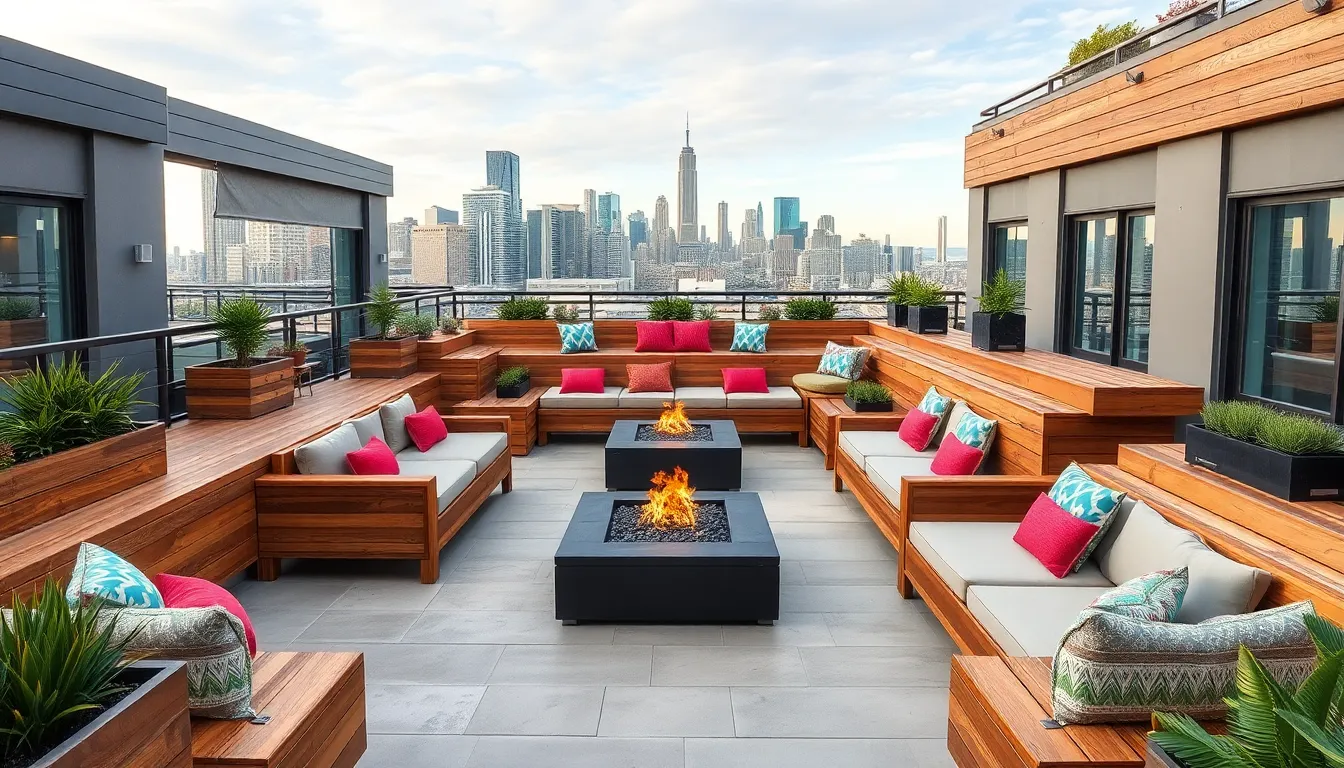
Building different elevation levels on your rooftop transforms a flat surface into ever-changing entertaining zones that serve multiple purposes simultaneously. Multi-level designs create distinct areas for dining, lounging, and socializing while making your space feel larger and more architecturally interesting.
Build Raised Platform Sections
Raised platforms physically separate different areas on your rooftop while adding visual depth and character to the overall design. We recommend constructing these elevated sections using wood decking or composite materials that contrast beautifully with your existing floor surface.
Platforms work exceptionally well for defining dining areas or creating elevated lounge spaces that offer better views of your surroundings. Building these raised sections helps establish clear pathways throughout your rooftop and creates cozy nooks that feel more intimate than open spaces.
Materials like natural wood or decorative tile add warmth and texture to your rooftop environment. Strategic platform placement also allows you to work with your rooftop’s existing features while creating functional zones that encourage different types of activities.
Create Step-Down Lounge Zones
Step-down lounge zones provide sunken areas that feel naturally secluded and perfect for relaxation or intimate conversations. These lowered spaces create a sense of privacy and comfort that’s often missing from typical rooftop designs.
Sunken lounges can be surrounded by built-in seating or decorative planters that form natural enclosures, shielding guests from wind while increasing the feeling of seclusion. We suggest incorporating fire pits or small water features into these zones to enhance the ambiance and create compelling focal points.
Conversation flows more naturally in step-down areas because the lowered positioning brings people closer together. These zones also provide excellent opportunities to install specialty lighting or unique flooring materials that distinguish the space from surrounding areas.
Install Built-In Seating
Built-in seating maximizes your available space by providing permanent, sturdy places to sit without cluttering your rooftop with movable furniture pieces. Benches can be seamlessly integrated into planter boxes, perimeter walls, or raised platform edges.
Custom built-ins save valuable floor space while creating design continuity throughout your rooftop entertainment areas. We recommend adding weather-resistant cushions and decorative pillows to enhance comfort and introduce color to your design scheme.
Dual-purpose built-in seating often doubles as storage space for outdoor essentials or provides additional surface area for drinks and decorative elements. Strategic placement of these permanent seating answers helps define traffic patterns and creates natural gathering spots that encourage social interaction.
Incorporate Weather Protection Elements
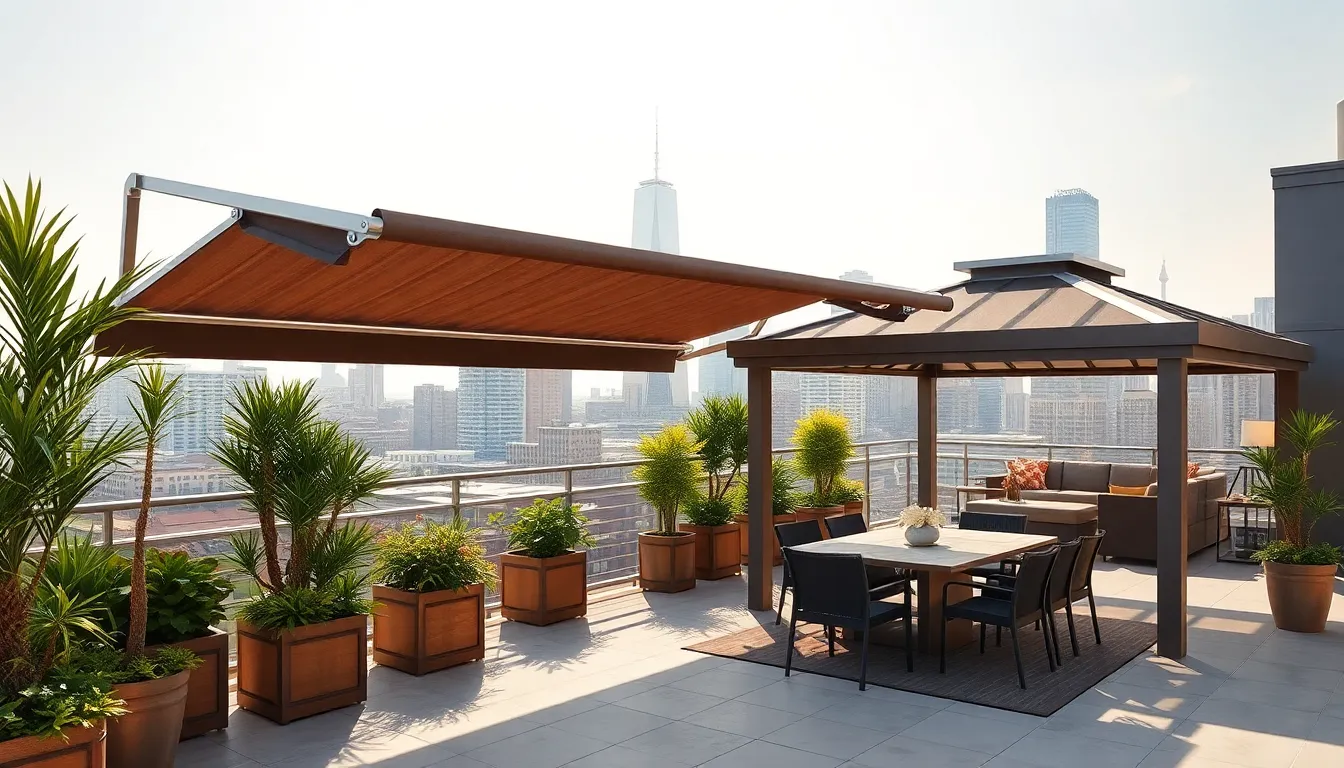
Weather protection transforms your rooftop patio from a seasonal space into a year-round retreat. Strategic installation of windbreaks, roofs, and covered areas ensures comfort regardless of outdoor conditions.
Install Windbreaks and Barriers
Strong winds can make even the most beautiful rooftop uncomfortable and unusable. Glass panels offer the most effective wind protection while maintaining unobstructed views of your surroundings. We recommend installing tempered glass barriers along the windiest sides of your rooftop to create a calm microclimate for relaxation.
Tall planters filled with dense shrubs serve dual purposes as living windbreaks and natural privacy screens. Strategic placement of these planters creates protected zones while adding greenery to your space. Lattice screens provide another versatile option that blocks wind while allowing air circulation through decorative patterns.
Metal and wooden barriers designed specifically for wind deflection offer durability and customizable aesthetics. These purpose-built answers integrate seamlessly with your rooftop design while providing reliable protection from gusty conditions.
Add Retractable Roof Systems
Retractable roof systems give you complete control over your rooftop environment throughout changing weather conditions. Modern louvered pergolas allow you to adjust shade coverage by angling the louvers, providing precise control over sunlight exposure while maintaining ventilation. These systems increase property value while offering the flexibility to open completely for stargazing or close during unexpected rain.
Motorized retractable awnings extend and retract at the touch of a button, making weather adjustments effortless. Advanced systems include wind sensors that automatically retract the covering when conditions become too gusty, protecting your investment. We’ve found that combining retractable elements with permanent structures creates the most versatile outdoor living experience.
Create Covered Dining Areas
Permanent covered dining areas ensure your outdoor meals aren’t interrupted by weather changes. Gazebos provide complete protection from rain and sun while creating an intimate dining atmosphere with defined boundaries. Solid roof constructions using aluminum, steel, or copper materials offer maximum durability and weather resistance for year-round use.
Pergolas with enhanced coverage using climbing plants or fabric panels create partially covered dining spaces with natural charm. Adding ceiling fans under these covered areas improves air circulation during hot weather while providing gentle lighting options for evening dining. We recommend incorporating heating elements like infrared heaters or fire features to extend the dining season into cooler months.
Deck board roofs topped with shingles and skylights combine complete weather protection with natural lighting, creating cozy dining environments that feel connected to the outdoors while staying protected from the elements.
Conclusion
Your rooftop holds incredible potential to become the perfect outdoor retreat. We’ve explored everything from lush gardens and cozy seating areas to sophisticated dining spaces and tranquil water features that can transform any urban rooftop into a stunning oasis.
The key to success lies in thoughtful planning that addresses your exact needs and challenges. Whether you’re working with a compact apartment balcony or an expansive penthouse terrace you’ll want to prioritize weather-resistant materials and strategic design elements.
Remember that creating your dream rooftop patio doesn’t have to happen overnight. Start with one or two features that excite you most then gradually build upon your foundation. With the right approach your rooftop will become the ultimate escape from city life – a place where you can entertain guests relax after long days and enjoy breathtaking views right from home.
Frequently Asked Questions
What are the best plants for a rooftop garden that can withstand harsh weather?
Hardy varieties like lavender, rosemary, and native species are ideal for rooftop gardens. These plants require less maintenance and can handle wind, sun exposure, and temperature fluctuations better than delicate varieties. Consider installing raised planter boxes to protect roots and improve drainage, while vertical garden walls maximize growing space.
How can I create privacy on my rooftop patio in an urban setting?
Use privacy screens made from various materials and combine them with natural elements like tall planters filled with dense shrubs. Strategic placement of decorative screens, bamboo panels, or tempered glass can create customizable enclosures. Layering different privacy solutions with plants creates an organic feel while blocking unwanted views.
What type of furniture works best for rooftop outdoor living spaces?
Choose durable materials like treated wood, aluminum, and synthetic wicker that can withstand weather elements. Modular furniture systems offer flexibility for various seating arrangements. Invest in weather-resistant cushions made from solution-dyed acrylic fabrics, and consider bar-height counters with comfortable stools for entertaining.
What shade solutions work best for rooftop patios?
Retractable awnings provide flexible protection and can withstand wind conditions with modern motorized controls. Pergolas offer architectural interest and can support climbing plants or fans, while gazebos provide full coverage for various weather conditions. These solutions ensure comfort throughout the day.
How can I add lighting to my rooftop space for evening use?
String Edison bulb lights create warm, intimate lighting zones with vintage charm. Solar-powered fixtures offer eco-friendly pathway and garden border illumination. Fire bowls and lanterns serve as stunning centerpieces, providing both warmth and ambiance while ensuring safety through proper placement.
Can I install a kitchen on my rooftop patio?
Yes, you can create an outdoor kitchen using weather-resistant materials for appliances and countertops. Build a grill station as a centerpiece under a pergola for shade and protection. Ensure proper ventilation, organized storage, and consider adding bar-height counters for a complete entertaining destination.
What water features work well on rooftops?
Small fountains require minimal water while providing soothing sounds and aesthetic appeal. Reflecting pools offer elegant sophistication by capturing sky and architecture reflections. Water walls are space-saving elements that create calming ambiance, all contributing to a tranquil urban retreat atmosphere.
How can I create different zones on my rooftop?
Build multi-level areas using raised platforms with wood decking or composite materials to create visual depth. Design step-down lounge zones for privacy and comfort, and incorporate built-in seating to maximize space. These distinct zones separate dining, lounging, and socializing areas effectively.
How do I protect my rooftop patio from wind and weather year-round?
Install windbreaks using tempered glass panels and tall planters with dense shrubs to create calm microclimates. Consider retractable roof systems for sunlight and ventilation control. Create covered dining areas with gazebos or enhanced pergolas to ensure year-round usability regardless of weather conditions.

